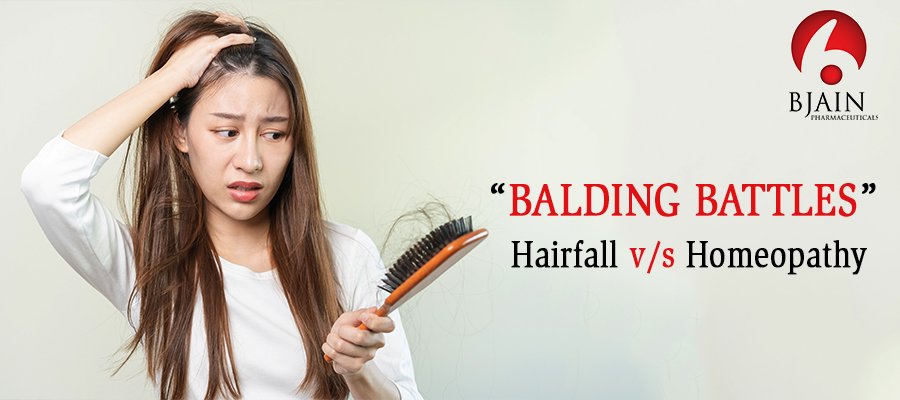“Hair fall” is one word you can’t ignore in any gathering or get-together. One person can initiate a whole thread of conversation lingering around Hair fall. Its presence in every conversation indicates its abundance. But do you think they all suffer from hair fall or is it an exaggeration of expression? For that, we need to know how much hair fall is normal and how much is a concern requiring attention. But first, let’s find out some in-depth knowledge about hair fall. You should keep reading this blog till the end because I might give you some interesting facts about hair fall and a few natural remedies. Did you know Homeopathy works wonders in cases of hair fall particularly Alopecia? We will get to know about that too!
What is Hair fall?
Most healthy persons shed as many as 100 hair strands each day. As the course of the hair development cycle, fresh locks emerge to replace those removed.
Alopecia (hair loss) is a disorder in which you lose more hair and less or none grows back. There are various forms of hair fall, and it may affect individuals of any gender or any age including kids.
How can hair fall impact our lives?
Hair loss can significantly impair a person’s confidence, interpersonal interactions, and mental wellness:
Self-confidence
Hair loss can cause emotions of poor self-esteem and lack of security. In society, hair is connected with attractiveness, vigor, and virtue, therefore losing it can make many feel less beautiful and weak.
Social life
Hair loss can harm someone’s social circle, including ridicule, embarrassment, and a fear of rejection. Those who lose their hair might be concerned about how they are seen in their private and professional lives.
Mental health
Hair loss can cause sadness, nervousness, and other mental issues. Someone who shed their hair may believe they appear elderly and are concerned about sacrificing their appeal to love relationships.
Work
In competitive job contexts, men with receding hair may be perceived as missing the modern skills that younger men possess.
Appearance
Baldness can make it harder to style hair, therefore people tend to wear caps or hats regardless of hot weather.
What are the different types of Hair fall?
People lose the speed of hair growth as their age advances and it may be one of the reasons behind continuous hair fall but we will discuss some more types of hair loss and their reasons.
- Involutional alopecia is a naturally occurring disorder where hair thins with age. Many hair follicles enter the resting stage, while the rest of the hair grows short and lesser in quantity.
- Androgenic alopecia is a hereditary disorder that may impact either males or women. Men with male pattern balding might experience a decrease in hair starting as early as their teenage years or early twenties. It is marked by an upward hairline and the progressive loss of hair from the top of the head and forehead. Women having this disorder, known as female pattern baldness, do not see visible reduction until their 40s or later. Women undergo overall hair thinning, with the top area showing the highest hair loss.
- Alopecia areata frequently begins quickly and produces spotty baldness in kids and adolescents. This disorder may cause full baldness (alopecia totalis). However, in around 90% of persons with the disease, hair regrows within a couple of years.
- Alopecia universalis is a condition that causes hair loss on the entire body, which includes brows, lashes, and hair on the pubic area.
- Trichotillomania, which most commonly affects youngsters, is a psychiatric illness when someone tears off their hair.
- Telogen effluvium is a short-term thinning of hair caused by alterations in the hair’s development cycle. A substantial amount of hair undergoes the rest stage simultaneously, resulting in hair loss and eventual thinning.
Can we prevent it even before its occurrence?
You may use a few scalp hygiene measures to boost your general hair wellness and potentially avoid hair loss.
1. Stay away from hairstyles that tug on your hair.
2. Steer clear of high-heat styling appliances.
3. Do not undergo various chemical treatments or bleach your locks.
4. Use a gentle shampoo that is appropriate for the type of hair you have.
5. Choose a delicate hair brush composed of natural fibers.
Which homeopathic medicines can be used for Hair fall?
Hair fall can have internal causes including some other underlying disorder. Homeopathy can help by treating the internal cause that will reflect externally in your hair health. Homeopathy works as a holistic system of medicine making it a perfect solution for your hair-related problems. There are a few Homeopathic medicines frequently indicated in cases of hair loss.
- Omeo Hair Care Drops: It is a complete trichotherapy that includes drops for internal use and for external use as well. The internal Hair care Drop helps with the underlying condition that can be the cause of your hair fall and the External Hair Care drop helps prevent hair fall, dandruff, and itching of the scalp. These drops are composed of well-known homeopathic medicines used to treat hair and scalp ailments. Omeo Hair Care (drops) from BJain Pharmaceuticals is a perfect solution for your all hair needs.
- Aloe socotrina is effective for managing hair loss caused by scalp conditions such as eczema or a condition called seborrheic dermatitis. It works particularly well if you have oily, scaling, or itchy scalp.
- Ammonium muriaticum can aid with baldness resulting from dandruff or scalp dryness. It also helps with stress-related hair fall and hormone abnormalities.
- Baryta carb is advised for age-related hair fall or prematurely greying. It works exceptionally well for elderly persons and those who are showing early indications of alopecia.
- Calcarea carb is beneficial for hair loss induced by hormonal imbalances, especially in postpartum women and those suffering from thyroid disorders. It is also beneficial for persons who have significant scalp perspiration.
- Lycopodium is great for treating hair fall related to anxiety, strain, or trouble with digestion. It is very beneficial for hair loss on both sides, temples, and crown area.
- Natrum mur is good for addressing hair loss caused by psychological strain, bereavement, or sadness. It’s also beneficial for people who have dandruff or an overly greasy scalp.
- Petroleum is beneficial for treating hair loss caused by scalp disorders such as psoriasis or dermatitis. It’s especially beneficial for people with dry, flaky, and irritating scalps.
- Phosphorus is a popular treatment for hair loss on the scalp, brows, and other body regions. It can also assist with hair loss caused by a disease or a hormonal disorder.

Dr Kiran Swami
Dr. Kiran Swami, BHMS, MD (Hom.), a Research Officer at BJain Pharmaceuticals Pvt. Ltd., holds degrees from Nehru Homeopathic Medical College, Delhi, and Dr. Sarvepalli Radhakrishnan Rajasthan Ayurved University, Jodhpur. With expertise in homeopathy and a passion for research, she drives innovation in holistic healthcare solutions.


